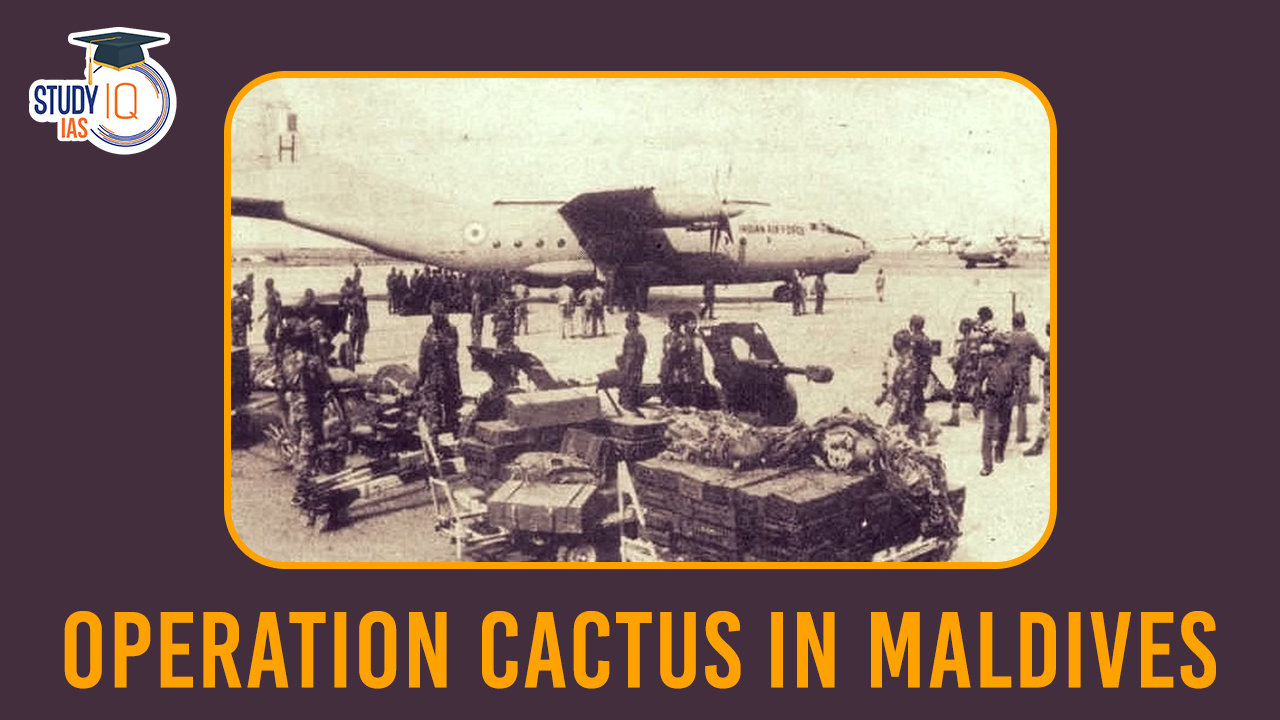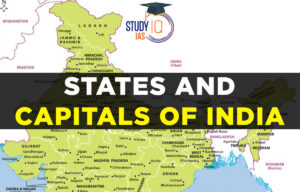Table of Contents
Operation Cactus in Maldives was an Indian military operation in 1988 to rescue President Maumoon Abdul Gayoom and restore his democratically elected government in the Maldives. The operation was launched in response to a coup attempt by a group of Maldivians led by businessman Abdullah Luthufi. Read the article below to learn about the background of Operation Cactus 1988 in Maldives.
We’re now on WhatsApp. Click to Join
What is Operation Cactus?
In 1988, Operation Cactus saw the Indian Armed Forces swiftly intervene in the Maldives to thwart a coup led by Abdul Luthufi with support from PLOTE militants. President Abdul Gayoom sought help, and Indian troops, deployed in November, successfully rescued him from Male without casualties. The operation showcased India’s regional security role effectively.
Operation Cactus in Maldives Overview
| Important Facts about Operation Cactus in Maldives | |
| Operation Name | Operation Cactus |
| Date | November 3-4, 1988 |
| Location | Maldives, Indian Ocean |
| Objective | Thwart a coup attempt and preserve the government of President Maumoon Abdul Gayoom |
| Coup Plotters | Led by Maldivian businessman Abdullah Luthufi, assisted by armed mercenaries from PLOTE |
| Indian Forces |
|
| High Commissioner | Arun Bannerjee (Indian High Commissioner to Maldives) |
| Landfall | Hulhulé, Maldives’ main airport |
Background of Operation Cactus 1988
- President Abdul Gayoom’s government faced coup attempts in 1980 and 1983, but they were less severe than the 1988 incident.
- In the latter, over 80 PLOTE cadres led by Maldivian businessman Abdul Luthufi infiltrated using a hijacked ship from Sri Lanka.
- Capturing vital infrastructure in Male, including TV and radio stations, ports, and airports, they held ministers hostage while relocating President Gayoom to the Maldives National Security Service headquarters.
- Seeking aid from nations like the US, Britain, Pakistan, Sri Lanka, Malaysia, and India, President Gayoom received assurances from the former two for coordinated support with India.
- Despite the challenges, India, led by Prime Minister Rajiv Gandhi, swiftly and affirmatively decided to intervene militarily on November 3, 1988.
Know here all about the India-Maldives Relations in detail.
Commencement of Operation Cactus 1988
Operation Cactus commenced on November 3, 1988, with the deployment of Indian forces including the 50th Independent Parachute Brigade’s 6th Battalion and the 17th Parachute Field Regiment. Airlifted by an Ilyushin-76 transport aircraft, they landed at Malé International Airport on Hulhule Island, commanded by Brigadier Frukh Bulsara.
Securing Malé and Engaging PLOTE Mercenaries
The Indian paratroopers swiftly secured the airfield and crossed to Malé using boats. A prolonged firefight ensued as they engaged PLOTE mercenaries, ultimately securing the capital city.
Casualties and Naval Interception
The operation resulted in approximately 19 casualties, mainly among the mercenaries, and two hostages killed by them. Indian Navy frigates intercepted the hijacked freighter off the Sri Lankan coast, disrupting the mercenary force’s arrival. The prompt military response and accurate intelligence played a crucial role in averting a political crisis in the Indian Ocean.
Aftermath of Operation Cactus
India received international praise for its intervention, with United States President Ronald Reagan acknowledging it as “an immense contribution to regional security.” However, some South Asian neighbors expressed disquiet.
Extradition and Trials
In July 1989, India extradited captured mercenaries to the Maldives for trial. Despite receiving death sentences, Indian pressure led to their commutation to life imprisonment by President Gayoom.
Accusations and Pardon
Businessman Abdulla Luthufi, based in Sri Lanka, was accused of funding and leading the coup. Former Maldivan President Ibrahi Nasir was also implicated but denied involvement. In July 1990, Nasir received a pardon in absentia due to his role in the Maldives’ independence struggle.
Strengthening Indo-Maldivian Relations
Operation Cactus contributed to the strengthening of Indo-Maldivian relations, solidifying ties between the two nations. The successful restoration of the Gayoom government further solidified the bond.
Strategic Imperative of Intervention
Scholars of India’s Foreign Policy argue that Operation Cactus became necessary to prevent external powers from intervening or establishing bases in the Maldives. The absence of Indian intervention could have posed a threat to India’s national interest, prompting the decisive action.
Other Assistance of India to the Maldives
| Year | Event/Assistance | Details |
| 1986 | Establishment of IGMH | India agreed to establish the Indira Gandhi Memorial Hospital (IGMH) in Male, a highly advanced tertiary care hospital in the Maldives. |
| 1988 | Operation Cactus | India launched Operation Cactus to successfully defend the Maldivian Government against a coup attempt. |
| 1996 | Establishment of MITE | The Maldives Institute of Technical Education (MITE) was established with grants in aid from India. |
| 2004 | Tsunami Relief | After the 2004 Tsunami, India was the first nation to send relief and aid to the Maldives, assisting in recovery efforts. |
| 2008 | Standby Credit Facility | India extended a standby credit facility of $100 Million to the Maldives during President Nasheed’s visit to Delhi. |
| 2014 | Operation Neer | India launched ‘Operation Neer’ during the drinking water crisis in the Maldives, supplying clean drinking water to Male. |
| – | ALH Gift | India gifted two Advanced Light Helicopters (ALH) to the Maldivian forces, enhancing their capabilities. |
| 2020 | Operation Sanjeevani | India supplied essential medicines and vaccines to the Maldives during the Covid-19 crisis under ‘Operation Sanjeevani.’ |
Operation Cactus UPSC
Operation Cactus in 1988 was an Indian military intervention in the Maldives to thwart a coup led by Abdullah Luthufi and PLOTE militants. President Gayoom sought aid, and India swiftly deployed forces, including the 50th Independent Parachute Brigade. Securing Malé, a firefight ensued with PLOTE, resulting in approximately 19 casualties. International praise followed, but some neighbors expressed disquiet. Extradited mercenaries faced trials, with Indian pressure leading to commuted sentences. Operation Cactus strengthened Indo-Maldivian relations, preventing external threats and showcasing India’s regional security role.


 World Veterinary Day 2025: Theme, Histor...
World Veterinary Day 2025: Theme, Histor...
 List of States and Capitals of India, Ma...
List of States and Capitals of India, Ma...
 World Intellectual Property Day 2025, Th...
World Intellectual Property Day 2025, Th...





















